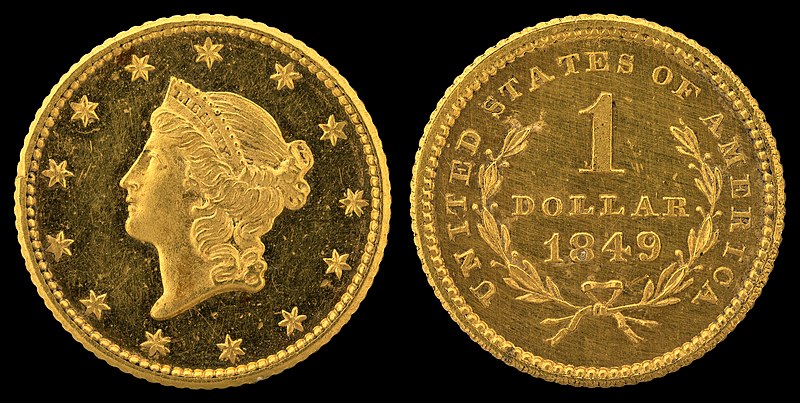The gold dollar or gold one-dollar piece was a coin struck as a regular issue by the United States Bureau of the Mint from 1849 to 1889. The coin had three types over its lifetime, all designed by Mint Chief Engraver James B. Longacre. The Type 1 issue had the smallest diameter of any United States coin ever minted.

A gold dollar had been proposed several times in the 1830s and 1840s, but was not initially adopted. Congress was finally galvanized into action by the increased supply of bullion caused by the California gold rush, and in 1849 authorized a gold dollar. In its early years, silver coins were being hoarded or exported, and the gold dollar found a ready place in commerce. Silver again circulated after Congress in 1853 required that new coins of that metal be made lighter, and the gold dollar became a rarity in commerce even before federal coins vanished from circulation because of the economic disruption caused by the American Civil War.
Gold did not again circulate in most of the nation until 1879; once it did, the gold dollar did not regain its place. In its final years, it was struck in small numbers, causing speculation by hoarders. It was also in demand to be mounted in jewelry. The regular issue gold dollar was last struck in 1889; the following year, Congress ended the series.
In 1831, the first gold dollar was minted, at the private mint of Christopher Bechtler in North Carolina. Much of the gold then being produced in the United States came from the mountains of North Carolina and Georgia, and the dollars and other small gold coins issued by Bechtler circulated through that region, and were now and then seen further away. Additional one-dollar pieces were struck by August Bechtler, Christopher's son.

| Design | Liberty wearing a coronet. Type 1. |
|---|---|
| Designer | James B. Longacre |
| Design date | 1849 |
| Design discontinued | 1854 |
A gold dollar had been proposed several times in the 1830s and 1840s, but was not initially adopted. Congress was finally galvanized into action by the increased supply of bullion caused by the California gold rush, and in 1849 authorized a gold dollar. In its early years, silver coins were being hoarded or exported, and the gold dollar found a ready place in commerce. Silver again circulated after Congress in 1853 required that new coins of that metal be made lighter, and the gold dollar became a rarity in commerce even before federal coins vanished from circulation because of the economic disruption caused by the American Civil War.
Gold did not again circulate in most of the nation until 1879; once it did, the gold dollar did not regain its place. In its final years, it was struck in small numbers, causing speculation by hoarders. It was also in demand to be mounted in jewelry. The regular issue gold dollar was last struck in 1889; the following year, Congress ended the series.
In 1831, the first gold dollar was minted, at the private mint of Christopher Bechtler in North Carolina. Much of the gold then being produced in the United States came from the mountains of North Carolina and Georgia, and the dollars and other small gold coins issued by Bechtler circulated through that region, and were now and then seen further away. Additional one-dollar pieces were struck by August Bechtler, Christopher's son.


I don’t know how should I give you thanks! I am totally stunned by your article. You saved my time. Thanks a million for sharing this article.
ReplyDeleteI really appreciate your skilled approach. These square measure items of terribly helpful data which will be of nice use on behalf of me in future.
ReplyDeleteI really appreciate your proficient approach. These Measure area unit of measurement unit things of really useful knowledge which is able to be of nice use on behalf of me in future.
ReplyDeleteVery informative, keep posting such sensible articles, it extremely helps to grasp regarding things.
ReplyDeleteHey keep posting such sensible and significant articles.
ReplyDelete